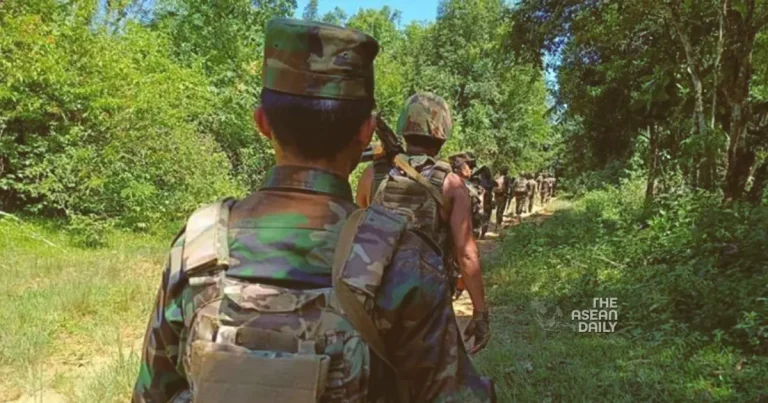8-5-2024 (MYANMAR) As the monsoon season descends upon Myanmar, a pivotal struggle for control is unfolding in the jungles of the southeastern Dawna Hills. Armed ethnic rebels are engaged in a fierce battle to hold back reinforcements dispatched by the country’s ruling junta, intent on reclaiming Myawaddy, a critical trading outpost on the Thai border. The outcome of this clash, and others like it across the nation, could determine the trajectory of a bloody conflict that has raged for over three years and ultimately shape the fate of the junta itself.
Myanmar has been plunged into chaos since the military coup in February 2021, which sparked the rise of an armed resistance movement now working alongside ethnic minority rebel groups, some of which have been fighting the military for decades. With the approach of the rain-laden monsoon clouds around early June, both sides find themselves in a race against time to secure strategic gains or hold their ground before the weather conditions hamper military operations.
In the balance lie vital trade and military outposts, including Myawaddy in the southeast, the western Rakhine region where the powerful Arakan Army has battered the junta, and pockets of other provinces along the borders with China and Thailand. These are areas that the junta will undoubtedly seek to retake or fortify before the rains arrive, even as the rebels strive to maintain their hard-won momentum.
“There are a couple of really important strategic objectives for the military in the coming weeks,” said Zachary Abuza, a professor at the US National War College and a specialist on Southeast Asia, referring to the ongoing battles for Myawaddy and towns in Rakhine state.
Since October, the junta has faced a string of battlefield defeats, compounded by a haemorrhaging economy, presenting the most significant challenge to its rule since seizing power. According to estimates by the United States Institute of Peace (USIP), the military has lost control of around half of its 5,280 military positions, including outposts, bases, and headquarters, and 60% of the territory it previously controlled in ethnic minority areas.
A Thai official and a diplomatic source, speaking on condition of anonymity, warned that the junta could lose control of all major borderlands with Bangladesh, China, India, and Thailand within the next six months if the current trajectory of fighting continues. These assessments suggest that the junta, stretched thin across frontier territories slipping from its grip, may be forced to consolidate its resources and prioritise key areas.
However, despite its weakened position and the loss of troops, the junta has retained the firepower to inflict significant damage on resistance groups and maintain a firm grip on the central lowland region, home to the majority Bamar people. Even if hemmed in, government forces could mount a robust defence and prolong the conflict, according to Thitinan Pongsudhirak, a senior fellow at the Institute of Security and International Studies of Chulalongkorn University in Bangkok.
“I think that this could drag on,” Thitinan said, referring to the turmoil engulfing the country. However, he added that the junta’s control was ultimately “untenable” in the long run. “The writing is on the wall,” he declared, pointing to the battlefield losses, an emboldened resistance, and a lack of popular support.
After losing control of Myawaddy, a conduit for border trade worth over $1 billion annually, the military has mounted a counter-offensive to reclaim the town. The Karen National Union (KNU), one of Myanmar’s oldest ethnic armies, which initially dislodged the military from Myawaddy, is now battling to hold back the junta’s assault.
“More than 1,000 troops are approaching and moving forward to Myawaddy, but KNLA joint forces are still trying hard to intercept, block, and attack them,” KNU spokesman Saw Taw Nee told Reuters, referring to the fighting between junta troops and the group’s armed wing, the Karen National Liberation Army. “Fierce fighting is taking place every day.”
Some 900 kilometres west of Myawaddy, the junta is engaged in a separate battle with the Arakan Army, which is pushing to gain control of Ann, a key regional military headquarters. The 793-kilometre Myanmar-China Gas Pipeline traverses Ann, with a major pump station located near the town, which analysts say the military will do everything to hold.
The impending monsoon rains will complicate the deployment of the military’s air power, a key advantage for the junta. Low cloud cover will impact the use of unguided munitions typically employed by its air force, said Richard Horsey, the Crisis Group’s senior Myanmar adviser. “It’s also harder and more dangerous for helicopters to operate in the monsoon — for transporting troops, resupplying bases that are cut off by anti-regime forces, and providing fire support,” he added.
Military defections across the country in recent months have indicated that the junta’s failure to resupply troops with food, water, ammunition, and medical supplies has led to collapsing morale, according to Abuza at the National War College.
The rains will hand an advantage to the resistance forces, who have the momentum of multiple victories but remain a diverse set of ethnic armies and grassroots resistance groups lacking critical coordination, analysts say.
“Facilitating strategic coordination among the plethora of groups will take time, but it will be a decisive factor in determining the outcome of the conflict in Myanmar,” said Ye Myo Hein of the USIP in a recent report.
Kyaw Zaw, a spokesman for Myanmar’s shadow National Unity Government, asserted that the junta currently only retained control over major cities in the heartland. “Even there, they are getting threatened,” he warned.




